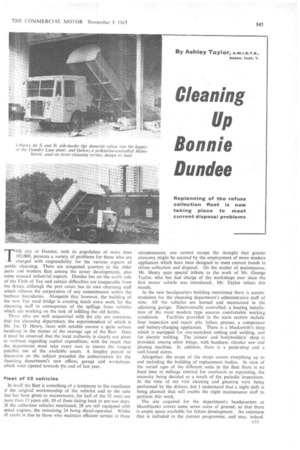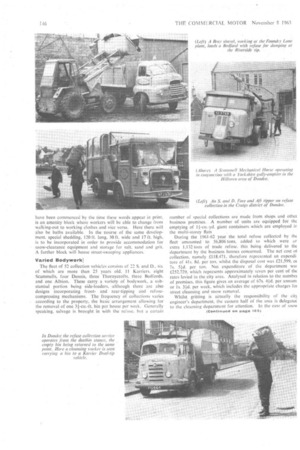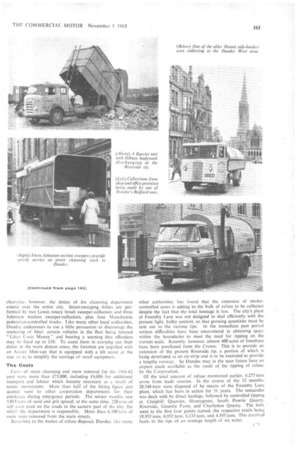• Cleaning Up Bonnie Dundee
Page 147

Page 148

Page 165

If you've noticed an error in this article please click here to report it so we can fix it.
THE city of Dundee, with its population of more than 182,000, presents a variety of problems for those who are charged with responsibility for the various aspects of public cleansing. There are congested, quarters in the older parts and modern fiats among the newer developments, plus sonic unusual industrial aspects. Dundee lies on the north side of the Firth of Tay and certain difficulties are inseparable from the docks, although the port estate has its own cleansing staff which relieves the corporation of any commitments within the harbour boundaries. Alongside this; however, the building of the new Tay road bridge is creating much extra work for the cleansing staff in consequence of the spillage from vehicles which are working on the task of infilling the old berths.
Those who arc well acquainted with the city are conscious that the cleansing department, the superintendent•of which is Mr. Jas. D. Henry, faces with notable success a quite serious handicap in the matter Of the average age of the fleet. Here it must be observed that the local authority is clearly not given to rashness regarding capital expenditure, with the result that the department must take every care to ensure the longest possible use of the available assets. A lengthy period of Jiscus,.ion on the subject preceded the authorization for the leansing department's new offices, garage and workshops. which were opened towards the end of last year.
Fleet of 52 vehicles In itself the fleet is something of.a testimony to the excellence )f the original workmanship of the vehicles and to the care hat has been given to maintenance, for half of the 52 units are nore than 13 years old, 10 of them dating back to pre-war days. Jf the collection vehicles mentioned, 28 are still equipped with aetrol engines, the remaining 24 being diesel-operated. Whilst ill credit is due to those who maintain efficient service in these circumstances, one cannot escape the thought that greater economy might be secured by the employment of more modern appliances which have been designed to meet current trends in refuse collection and disposal. On the matter of maintenance, Mr. Henry pays special tribute to the work of Mr. George Taylor, who has had charge of the workshops ever since the first motor vehicle was introduced. Mr. Taylor retires this month.
In the new headquarters building mentioned there is accommodation for the cleansing department's administrative staff of nine. All the vehicles are housed and maintained in the adjoining garage. Electronically controlled, a heating installation of the most modern type ensures comfortable working conditions. Facilities provided in the main section include four inspection and repair pits, lathes, presses, a compressor and battery-charging appliances. There is a blacksmith's shop which is equipped for oxy-acetylene cutting and welding, and for electric welding. The joiners' and bodybuilders' shop is provided, among other things, with bandsaw. circular saw and planing machine. In addition, there is a paint-shop and a well-found stores.
Altogether, the scope of the shops covers everything up to and including the building of replacement bodies. In view of the varied ages of the different units in the fleet there is no fixed time or mileage interval for overhauls or repainting, the necessity being decided as a result of the periodic inspections. At the time of my visit cleaning and greasing were being performed by the drivers, but I understand that a night shift is being planned that will enable the night maintenance staff to perform this work.
The site acquired for the department's headquarters at Marchbanks covers some seven acres of ground, so that there is ample space available for future development. An extension that is included in the current programme, and may. indeed,
have been commenced by the time these words appear in print, is an amenity block where workers will be able to change from walking-out to working clothes and vice versa. Here there will also be baths available. In the 'course of the same development. special shedding, 120 ft. long, 30 ft. wide and 17 ft. high, is to be incorporated in order to provide accommodation for snow-clearance equipment and storage for salt. sand and grit. A further block will house street-sweeping appliances.
Varied Bodywork
The fleet of 52 collection vehicles consists of 22 S. and D.. six of which are more than 25 years old, 11 Karriers. eight Scarnmells, four Dennis, three Thornycrofts, three Liedfords, and one Albion. These carry a variety of bodywork, a substantial portion being side-loaders, although there are also designs incorporating frontand rear-tipping and refusecompressing mechanisms. The frequency of collections varies according to the property, the basic arrangement allowing for the removal of one 3i-cu.-ft. bin per house per week. Generally speaking, salvage is brought in with the refuse. but a certain number of special collections are made from shops and othct business premises. A number of units are equipped for thc emptying of 17;-cu.-yd. giant containers which are employed it the multi-storey flats During the 1961-62 year the total refuse collected by the fleet amounted to 56,806 tons, added to which were ar extra 1,132 tons of trade refuse, this being delivered to the department by the business houses concerned. The -net cost 01 collection, namely £118,471. therefore represented an expendi, ture of 41s. 8d. per ton, whilst the disposal cost was £21,599, oi 7s. 51c1. per ton. Net expenditure of the department wa5. £252,729, which represents approximately seven per cent of the rates levied in the city area. Analysed in relation to the numbei of premises, this figure gives an average of 67s. 41d. per annum or Is. lid. per week, which includes the appropriate charges for street cleansing and snow removal.
Whilst gritting is actually the responsibility of the cif) engineer's department, the eastern half of the area is delegatec to the cleansing department for attention. In the case of snow
clearance. however, the duties of the cleansing department extend over the entire city. 'Street-sweeping duties are performed by two Lewin rotary. brush sweeper-collectors and three Johnston suction sweeper-collectors, plus four Manulectric pedestrian-controlled trucks. Like many other local authorities, Dundee endeavours to use a little persuasion to discourage the scattering of litter. certain vehicles in the fleet being lettered "Litter Costs Money," and bearing a warning that Offenders may be fined up to flO. To assist them in carrying out their duties in the more distant areas, the foremen are supplied with an Austin Mini-van that is equipped with a tilt cover at the rear so as to simplify the carriage of small equipment.
The Costs Cost,, of street cleansing and snow removal for the 1961-62 year were more than £75,000, including £9,606 for additional transport and labour which became necessary as a result of severe snowstorms More than half of the hiring figure just quoted went to other corporation departments for their assistance during emergency periods. The winter months saw .3,015 tons of sand and grit spread; at the same time. 220 tons of salt sere used on the roads in the eastern part of the city. for which the department is responsible. More than 6300 tons of snow were removed from the main streets..
Returning to the matter of refuse disposal, Dundee. like many other authorities, has found that the extension of smokecontrolled areas is adding to the bulk of refuse to be collected despite the fact that the total tonnage is less. The city's plant at Foundry Lane was not designed to deal efficiently with the present 'light, bulky content, so that growing quantities must be Sent out to the various tips. In the immediate past period serious difficulties have been encountered in obtaining space Within the boundaries to meet the need for tipping on the current scale. Recently, however, almost 400 acres of foreshore have been purchased from the Crown. This is to provide an extension of the present Riverside tip, a portion of which is being developed as an air-strip and is to be extended to provide a lengthy runway. So Dundee may in the near future have an airport made available as the result of the tipping of refuse by the Corporation.
Of the total amount of refuse mentioned earlier, 6,275 tons arose from trade sources. In the course of the 12 months. 20348 tons were disposed of by means of the Foundry Lane plant, which has been in action for 31 years. The remainder was dealt with by direct haulage, followed by controlled tipping at Craighill Quarries, Honeyereen, South Powrie Quarry. Riverside, Gourdie Farm, and Charleston Quarry. The hulk went to the first four points named, the respective totals being 18.953 tons, 6,932 tons. 6,133 tons. and 4.595 tons, This involved hauls to the tips of an average length of six miles.














































































































































































































































